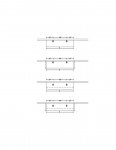(C) Countertops. In kitchens, pantries, breakfast rooms,
dining rooms, and similar areas of dwelling units, receptacle
outlets for countertop spaces shall be installed in accordance
with 210.52(C)(1) through (C)(5).
Where a range, counter-mounted cooking unit, or sink
is installed in an island or peninsular countertop and the
width of the countertop behind the range, counter-mounted
cooking unit, or sink is less than 300 mm (12 in.), the
range, counter-mounted cooking unit, or sink is considered
to divide the countertop space into two separate countertop
spaces as defined in 210.52(C)(4). Each separate countertop
space shall comply with the applicable requirements in
210.52(C).
(1) Wall Countertop Spaces. A receptacle outlet shall be
installed at each wall countertop space that is 300 mm
(12 in.) or wider. Receptacle outlets shall be installed so
that no point along the wall line is more than 600 mm
(24 in.) measured horizontally from a receptacle outlet in
that space.

